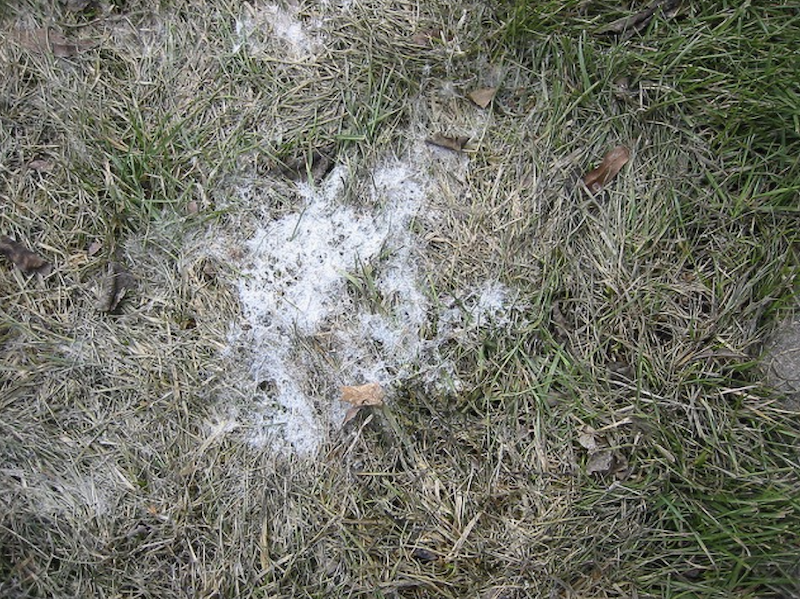Winter isn’t a particularly good time for your lawn. Extremely cold weather can severely harm your plants. However, the problems that developed in winter don’t go away once spring arrives. If you don’t pay attention, your lawn could be in a bad shape all year long. Thus, here are our tips on fixing the 5 most common lawn problems after winter.
1) Controlling Snow Mold
Source: https://www.flickr.com/photos/noricum/436856222
During the winter, it’s normal to see your lawn grass entirely covered with a thick layer of snow. Ideally, you should be seeing the return of lush, green growth by spring. What you might not expect is seeing several patches of unsightly, dull, and discolored grass early in the spring. In this case, your lawn has become the victim of what is commonly referred to as a snow mold.
Snow mold is a mold disease that can appear and spread to your lawn no matter the intensity of snowfall in your area. As long as the weather is cool or if there is rainfall, snow mold can become active enough to proliferate. Worse, this disease infects almost all grass varieties.
Thankfully, it’s not hard to control the disease. Just rake the infected patch to allow the grass to grow better. It’s likely that the ground is still wet just after winter, so you should rake the grass lightly. Raking hard could easily damage the grass.
Furthermore, practices common when you maintain a lawn in spring will help prevent the spread of snow mold disease. For one, you can apply fertilizer to ensure that the soil gets enough nutrients for the grass to absorb. Second, raking away thick layers of thatch should help. Third, gradually lowering the mowing height is necessary. The grass should only be two inches away from the soil surface after several mowing operations.
Here is a video about snow mold:
https://www.youtube.com/watch?v=t6CgWA7w3TE
2) Vole Damage
Source: https://pixabay.com/en/nutria-coypu-beaver-tail-rat-tail-2591617/
Apart from the snow mold diseases, voles can wreak havoc on your lawn. These rodents are characterized by their small ears and short tails. During winter, they seek refuge under the snow to consume your grass. They pull up the roots since they eat them too alongside the grass blades. Some homeowners think that moles are the ones damaging their lawns in winter. However, those animals aren’t active during winter.
Once spring arrives, you can see the trails of destroyed grass that they left. At this point, you might have to overseed your lawn. However, prevention is always better, so you should mow your lawn after winter. Similar to controlling snow mold disease, keeping the grass height at just two inches is effective against voles. Due to the short height, the voles won’t be able to hide under any thick patches of grass.
3) Proliferation of Crabgrass
One of the peskiest weeds is the crabgrass. Apart from ruining the appearance of your lawn, crabgrass could lead to soil erosion once they succumb to frost. After winter, you can apply corn gluten meal to control crabgrass. This is a natural solution that won’t expose your lawn to any harmful chemicals.
Moreover, applying spring fertilizer on your lawn will also prevent the spread of crabgrass. In contrast to the first two problems, the grass height shouldn’t be kept sort. If you have a crabgrass infestation, it’s best to keep the grass at a minimum height of 3.5 inches above the soil surface.
4) Bare Lawn Patches
Source: https://pixabay.com/en/rush-meadow-space-landscape-359734/
Due to plant diseases and pests, your lawn could have bare patches. Worse, these empty sections on your lawn can become the haven of harmful weed grasses if you don’t grow new grass there. Thus, the ideal fix for bare patches is to begin growing new lawn grass.
First, you need to dig up the affected area. Next, even out the soil surface and apply compost or any starter fertilizer. You can plant any cool-season grass varieties such as ryegrass and Kentucky bluegrass since they actively grow in early spring. Just irrigate regularly to give them enough moisture for germination.
5) Compacted the Soil
In winter, the ground gets covered with snow. During this period, the soil surface can suffer from too much snow and foot traffic. When the soil is too compacted, it becomes difficult for the root systems of the grass to absorb nutrients and grow well.
The solution is to break up the soil through aeration. Buy or rent a lawn aerator and begin to create holes in the ground to allow better air circulation. If you don’t have time, you can pay for professional services to aerate your lawn.
In conclusion, you should take good care of your lawn. Many problems can appear once winter is done and spring arrives, so it’s important that you are well-informed about fixing them. We hope that our guide helped you manage your lawn better. If you have any questions, you may send us a comment.




